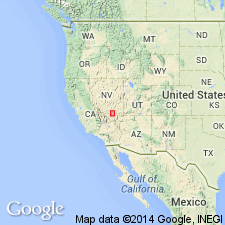
- Usage in publication:
-
- Belted Range Tuff*
- Modifications:
-
- Named
- Dominant lithology:
-
- Tuff
- AAPG geologic province:
-
- Great Basin province
Summary:
Name applied to rocks that crop out over a large area of southern Belted Range (the type area), the Kawich Range, and Pahute Mesa vicinity, western part of Nevada Test Site, west of long 116 deg 15 min, Nye Co, NV in the Great Basin province. Is equivalent to the part of the Indian Trail Formation (restricted to area east of long 116 deg 15 min) from the base of the Tub Spring to top of Grouse Canyon Members, and including some of the local informal units between these two members and equivalent to the members. Belted Range unconformably overlies and underlies local informal units. The Tub Spring (base) and Grouse Canyon (top) Members which can be recognized an extensive area (distribution map) are assigned to the Belted Range in the west part of the Test Site. Nomenclature chart. Both members are compound cooling units of comenditic (peralkaline soda-rhyolite) ash-flow tuff. Soda-rich sanidine is the dominant phenocryst mineral in both. Fayalite, apatite, zircon, and soda iron-rich clinopyroxene are minor ubiquitous phenocrysts. Grouse Canyon is quartz free. Tub Spring contains abundant quartz. Of Miocene or Pliocene age.
Source: GNU records (USGS DDS-6; Denver GNULEX).
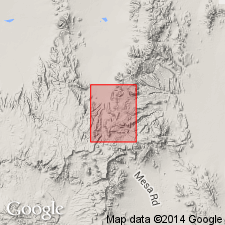
- Usage in publication:
-
- Belted Range Tuff*
- Modifications:
-
- Age modified
- AAPG geologic province:
-
- Great Basin province
Summary:
Mapped in Quartet Dome 7.5' quad, Nye Co, NV, where it is as much as 410 ft thick and comprises both Tub Spring and Grouse Canyon Members. Unconformably overlies unnamed rhyolites and ash-fall units. Underlies bedded tuff of Paintbrush Tuff of Miocene(?) and Pliocene age. Assigned Miocene and Pliocene(?) age.
Source: GNU records (USGS DDS-6; Menlo GNULEX).
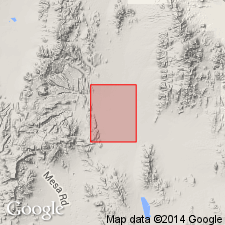
- Usage in publication:
-
- Belted Range Tuff*
- Modifications:
-
- Mapped
- AAPG geologic province:
-
- Great Basin province
Summary:
Mapped in Groom Mine SW 7.5' quad, Nye and Lincoln Cos, NV, where it is 150 to about 350 ft thick and contains only Tub Spring Member which is Miocene age.
Source: GNU records (USGS DDS-6; Menlo GNULEX).
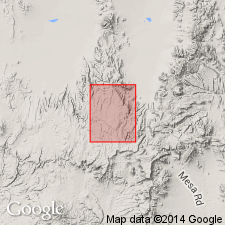
- Usage in publication:
-
- Belted Range Tuff*
- Modifications:
-
- Mapped
- AAPG geologic province:
-
- Great Basin province
Summary:
Mapped in Dead Horse Flat 7.5' quad, Nye Co, NV, where it is as much as 270 ft thick and includes both Tub Spring and Grouse Canyon Members. Assigned Miocene and Pliocene(?) age.
Source: GNU records (USGS DDS-6; Menlo GNULEX).
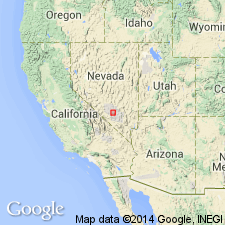
- Usage in publication:
-
- Belted Range Tuff*
- Modifications:
-
- Age modified
- AAPG geologic province:
-
- Great Basin province
Summary:
Age is late[!] Miocene on basis of 15 to 13 Ma assigned to volcanic center located on eastern Pahute Mesa. Silent Canyon caldera formed during and/or just after eruption of Belted Range Tuff. [DNAG Scale, 1983, would be "middle Miocene"]
Source: GNU records (USGS DDS-6; Menlo GNULEX).
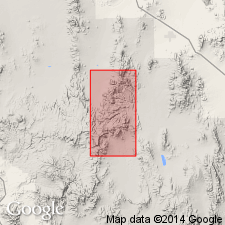
- Usage in publication:
-
- Belted Range Tuff*
- Modifications:
-
- Areal extent
- AAPG geologic province:
-
- Great Basin province
Summary:
Belted Range Tuff extended southward since Indian Trail Formation is restricted from Wheelbarrow Peak-Rainier Mesa area. Belted Range Tuff is mapped in Wheelbarrow Peak-Rainier Mesa area where it is as much as 660 ft thick and includes both Tub Spring and Grouse Canyon Members. Age shown as Miocene.
Source: GNU records (USGS DDS-6; Menlo GNULEX).
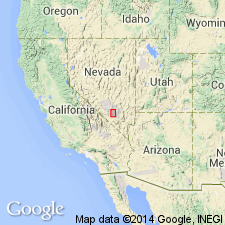
- Usage in publication:
-
- Belted Range Tuff*
- Modifications:
-
- Areal extent
- AAPG geologic province:
-
- Great Basin province
Summary:
Indian Trail Formation at Nevada Test Site and vicinity is herein abandoned. Belted Range Tuff including its members should now be used throughout Nevada Test Site and vicinity. Ash flows from lower member of Indian Trail Formation now included in (ascending): Fraction Tuff, Redrock Valley Tuff and Crater Flat Tuff (all three geographically extended).
Source: GNU records (USGS DDS-6; Menlo GNULEX).
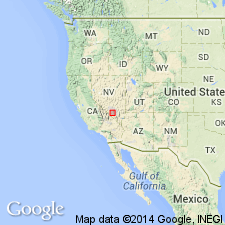
- Usage in publication:
-
- Belted Range Group*
- Modifications:
-
- Age modified
- Geochronologic dating
- Revised
- AAPG geologic province:
-
- Great Basin province
Summary:
Within southwest Nevada volcanic field, Nye Co, NV, Great Basin province, units previously of formation rank are raised to group rank to allow for combining petrographically, geochemically, and temporally related lava flows and nonwelded tuffs with the principal correlative welded ash-flow tuff sheets (formerly members of the previous formation-rank tuffs). The ash-flow sheets are raised to formation rank and designated as "Tuff." Belted Range is raised to group rank and revised to include the following units (ascending): comendite of Split Ridge (formerly rhyolite of Split Ridge), Grouse Canyon Tuff (rank raised), and Dead Horse Flat Formation (new; formerly tuff and lava of Dead Horse Flat and volcanics of Saucer Mesa). Tub Spring Tuff is raised to formation rank and removed from Belted Range. Overlies Lithic Ridge Tuff; underlies Crater Flat Group (rank raised). Nomenclature chart (table 1). 40Ar/39Ar age determinations (table 3) ranging from 14.0 +/-0.09 Ma on biotite from lava of Tram Ridge to 13.5 +/-0.02 Ma on sanidine from Dead Horse Flat Formation indicate a Miocene age.
Source: GNU records (USGS DDS-6; Denver GNULEX).
For more information, please contact Nancy Stamm, Geologic Names Committee Secretary.
Asterisk (*) indicates published by U.S. Geological Survey authors.
"No current usage" (†) implies that a name has been abandoned or has fallen into disuse. Former usage and, if known, replacement name given in parentheses ( ).
Slash (/) indicates name conflicts with nomenclatural guidelines (CSN, 1933; ACSN, 1961, 1970; NACSN, 1983, 2005, 2021). May be explained within brackets ([ ]).

